Gujjars During :
Solankis
Ghanzni
Ghori
Slaves
Afghans
Iranians
Changez khan
Babar
Moghals
Britishers
Present Kingdoms
Present Situation
Education in Gujjars
Gujjars in News
World Famous Gujjars
What Gujjars need
Gujjars Forum
2.1 Kushans and Nagars
In 1st century AD they had established two reigns of two dynasties which were those of Nagars and Kushan. One ruled Patna, which included Bengal, Bihar, Orissa, Uttar Pradesh and Central India. This was ruled by Nagar Dynasty of Gurjars. The King was Maharaja Subhau Nagar.
Their second kingdom was that of Peshawar which spread up to the river
Yamuna and
Afghanistan.
This kingdom was ruled by the dynasty of Kushan Gurjars (One of the five Yu-chee
tribes) whose king was emperor Kanishka. One of the edicts revealed that
“Kushans had named the territory
of
Sutlej as
Gujarat”.
During the reign of king Kanishka and Subhao Nagar, the Aryavarta was at its
peak of glory.
These kingdoms had
spread their trade up to
Europe.
2.2 Yuhezhi or yuchi
Yuezhi, In Chinese the name translates literally as 'Moon Clan.' According to ‘Zhang Guang-da’ the name Yuezhi is a transliteration of their own name for themselves, the Visha (the tribes), being called the Vijaya in Tibetan meaning ‘Victory’ in Sanskrit or Hindi. Chinese sources describe the Guishuang i.e. the "Kushans", as one of the five tribes of the Yuezhi i.e. Gurjars*. The other four tribes are known in Chinese history as Xiūmì, Shuangmi, Xidana, and Dūmì.
* Yu-chee was the Chinese corrupted form of the word Gurjar. Applying the Chinese language phonetic rules the word ‘Gurjar’ becomes “G-yuchee” (where G is silent). The Chinese scholar ‘Heun-Tsang’, who came to India in around 600 AD, also called the Gurjara kingdom as k-yuchee-lo (Gurjara). He added “lo” in the end to highlight the ‘a’ (Gurjar”a”) which was the sanskrtinised version of Gurjar.
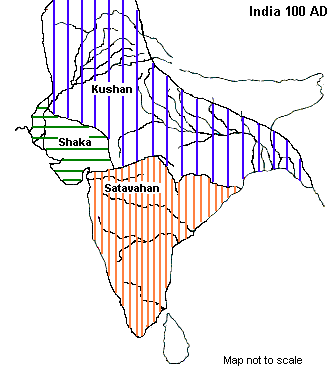
Map 2.2 Map shows the location of yuezhi before their migration to Indian subcontinent
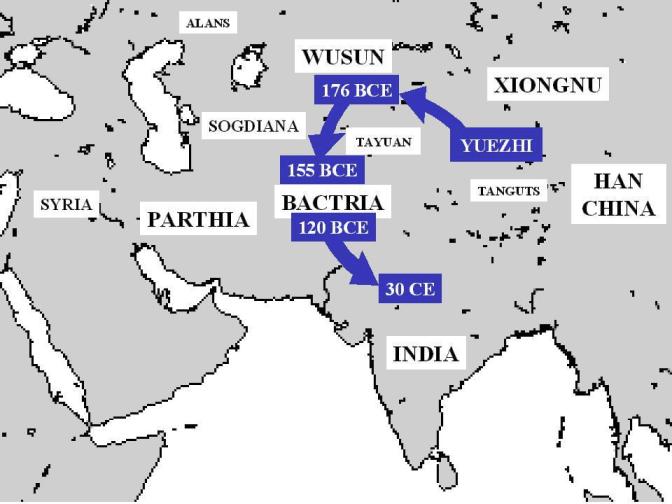
Map 2.3 Map shows the migration of Yuezhi
Yuhezhi was made of five main tribes,* these tribes were Kasana (Guiishang), Gorsi (better known as Gorzai tribe), Khatana (got their name from Khotan), Nagdi and Bargat. All other Gurjar clans originated from these five main tribes. The controversial province of Russia, Chechenya, was also named after “Chechi”. The Capital name is Grozny, prounounced as Gorzni (notice the Gorsi or Gorzi Gurjar clan) by Chechens. We still find many Chechens using the surnames like “Kasanav, Chichi, Bagrate and Basayev etc. (The famous Bagrate dynasty of Georgia and well known rebel leader Shyamil Basayev of Chechenya)
* Almost every Gurjar know this very fact that Gurjars were originally divided similarly in five main clans and their confederation was known as Chechi (it was the corruption of the word Yuezhi, similarly as Sindhu was called Hindu by Arabic and later this hindu was made Indu or India by britishers). Today we have a large chechi clan of Gurjar comprising of more than 10 laks people spread all over Indian subcontinent, If we include people who are not aware of their Gurjar origin then this chechi population might well go up to 30-40 lacs as we find numerous chechis in USSR.
|
Ä It is a well known fact in the area of Mathura (the place where Sri Krisna was born and ruled), that the famous lady love of Sri Krisna named “Radha” was from Chechi gotra of Gurjars. Today also we find many songs about her, addressing her as a Gujariya (fem. of Gurjar). She was from a nearby village named Barsana which is a Gurjar villageeven today; she was also called “Barsane ki Gujariya. We also find the temples of her friend Sakhi Gujari Lalita Devi in another nearby village names Uncha-gaon. This place is thickly populated with Gurjars.
Ä The consort of Lord Brahma Gayatri Devi (Goddess of knowledge and writer of all the Vedas) was from the same chechi tribe. Bramha married Gayatri Devi at pushkar which is the only pilgrim of Gurjars and it is also said that a Gurjar must go to pushkar once in his lifetime. It is a common belief that the Gurjar caste would gain liberation after death only if their ashes were scattered on Pushkar lake [i]
|
2.3 Kushans or Guishuang
The reign of Gurjar emperor Kanishka spread up to Central Asia as a result of which the Gurjars could be seen dwelling in Afghanistan, Russia and Iran even these days. It is believed that the emperor Kanishka had established his capital somewhere in Kashmir. It would be wrong to say that the present territorial boundaries of Kashmir are correct rather it was far wide spread than what it is today. These brave Kushan kings of those bygone days had subdued the countries like Kabul and Kandhar.
2.4 Some Famous Kushan Kings:
Vima Kadbises name corrupted* (45-78 AD)
Kanishka (103-127 AD)
Huveshka (127-155 AD)
Vasudeva (180-226 AD)
Kanishka-3 (255-275)
* Actual Name was Bheem Khalvijay, The Yuezhi people were also called Bisa people in Chinese and Tibetan records, where Bisa stands for victory (derived from Sanskrit word Vijay).
The Most Famous of these Kushans rulers was Emperor Kanishka, who ruled between 103 and 130 A.D. He was suffocated to death by his Brahmin Priests due to his transformation to Buddhism.
Note: There has always been confusion among Historians regarding the reign of Kanishka Ruled.
2.5 Other ruler tribes during the Rule of Kushans
All contemporary rulers (Except Satvahanas) were either feudatories or subjugated by Kushans
- Arjunaynas (A sect of Malwas)
- Bhattis (Yaduvamshi rulers of Sialkoat, joined Gurjars and then Rajputs)
- Gakkhar (Sassanians or Persians)
- Junjuas (A Jit or Jat tribe) (might be related to Juan-Juans or ‘Rourans’ or Tartars)
- Kambojas (a cavalier tribe, loyal to Kushans)
- Kidarites or Chionites (The Kushanshahs, Later known as Red Huns)
- Ksudrakas (Most probably bheels and other forest tribes)
- Lahingas
- Licchavis (Persian Nisbis, somehow related to Kushans by blood) ruled Nepal after 185 AD
- Malvas (Residing near Punjab, were always in conflict with Sakas and Uttamabhadras)
- Nagaras or Nangri (Gurjar Rulers of Mathura, related to Kushans)
- Sakas (Sakai, Sun worshippers, Scythian origin, known as Kshtrapas)
- Tusharas (or Tukharas, Most probably were a sect of Kambojas)
- Uttamabhadras
- Western kshatrapas (Sakas)
- Yaudheya or Johiyas (Gurjar rulers of western Punjab, A sect of Malwas)
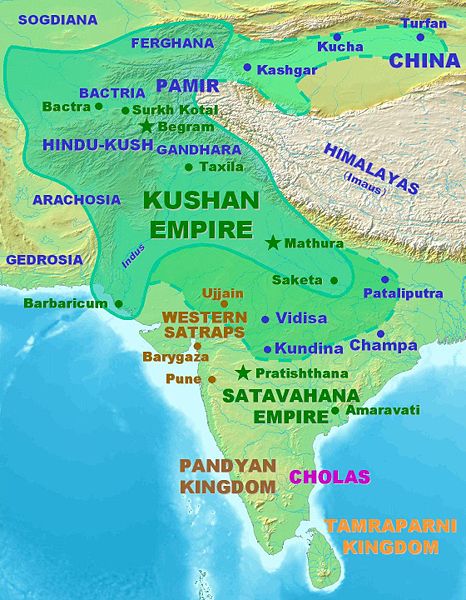
Map 2.4 Map above shows the stretch of Kushan Kingdom during 1st century
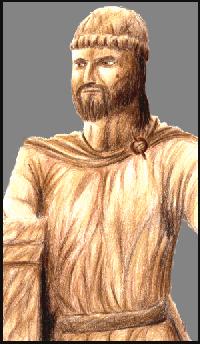
Picture 2.1 Ancient sketch of Kanishka
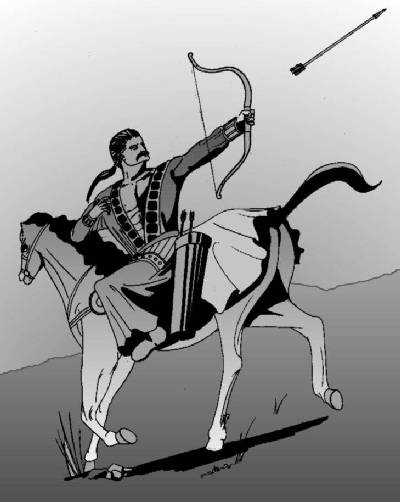
Picture 2.2 Kushan Cavalry Archer, Gurjars were always famous for there cavalry.
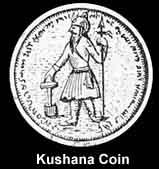
Picture 2.3 Kushans’ coin
2.6 Decline of Kushans
The Great Kushan Empire started declining after the death of Vasudeva in 226 AD. Though, the last king Kipunada, “Name Corrupted” (350-375 AD) ruled up to 375 AD.
Sassaninan king Shapur II fought and made a treaty with the Kushanas in 350 AD, but he was defeated by them twice in 367-368 AD. Later the Kidarites claimed independence and captured Afghanistan and nearby area. The Yudheyas, bhattis and Nagars were also in continuous internal conflicts. Finally, in 375 AD, The Kushans Empire collapsed and retired.
Following factors were responsible for their fall
Ø Most of the feudatories claimed independence
Ø Continuous fights with Xionites or Red Huns.
Ø Rise of Gupta Dynasty in 320 AD
Ø Conflicts with Indo-Sassanians.
2.7 New settlements of Kushans
Some of them moved to Himalayas: This branch of Kushans kept ruling a large part of Himachala. They were the forefathers of the forthcoming Naga Dynasty of Kashmir.
A branch of these Kushans went to Afghanistan and Persia: These Kushans were found ruling Persia in 4th and 5th centuries. They ruled as KushanShahs, The Famous Shahi dynasty which ruled sind till early 8th century were also one of these Kushan or kushanshah Rulers. They were also knows as Kidarites or Red Huns (Though they were not pure Huns). Present day Shahs of Gujarat and Sind are the progeny of those great warriors.
Some of them went downwards: and finally settled in Gujarat and southern Rajsthan and occupied the territories of Western Kshatrapas (Sakas). They started ruling Southern Rajasthan and Gujarat under several branches as petty rulers. These branches were namely Chapotkats, Nagars, Yudheyas, Awanas etc. Perhaps Gurjars ruled as feudatories to Guptas till 455 AD. The Gupta Empire collapsed due to the Hun attack under Torman in 467 AD. These Gurjar Clans became independent, though they kept fighting against the Huns and defeated them.
2.8 The final settlement in Gujarat & Rajasthan (Collectively known as Gujardesa)
The numerous Saka populations were residing at Gujarat and southern Rajasthan under Kshatrapas since 35 AD. The Kshatrapas collapsed in 405 AD After that this remaining Saka population was assimilated into Gurjars by the newly formed Gurjar groups (later Kushans).